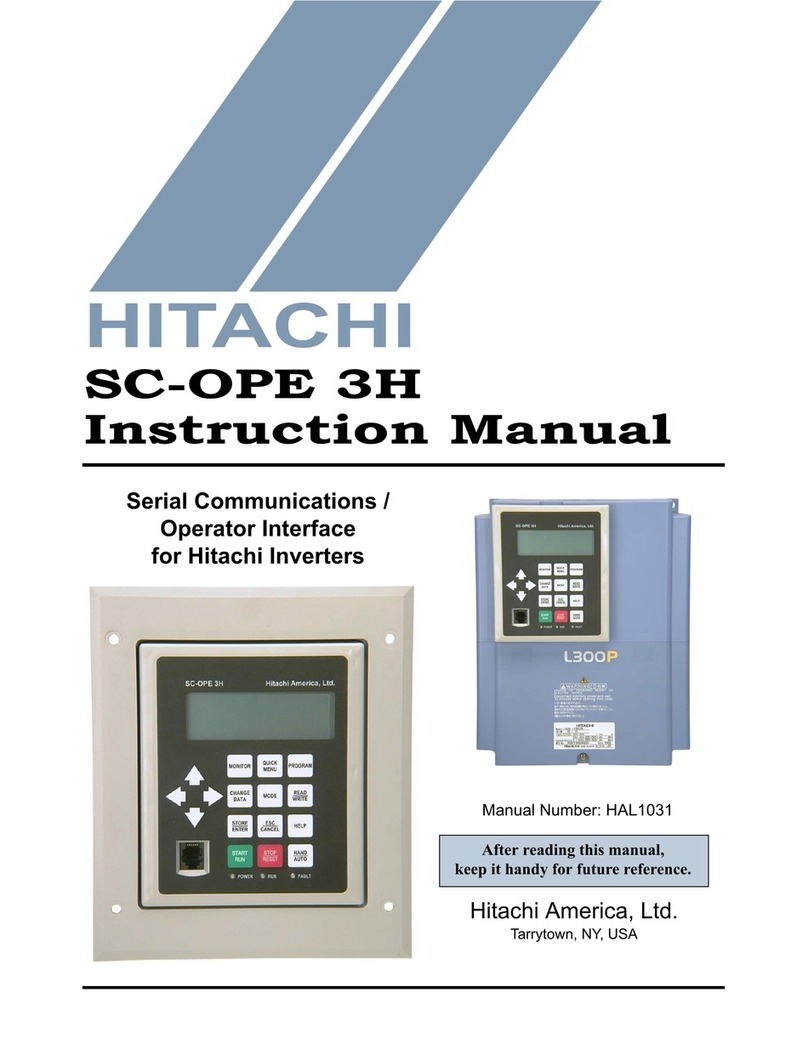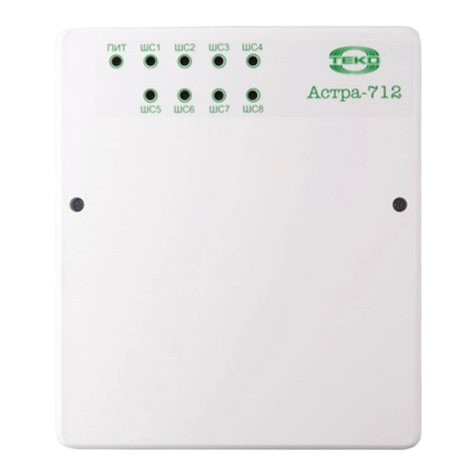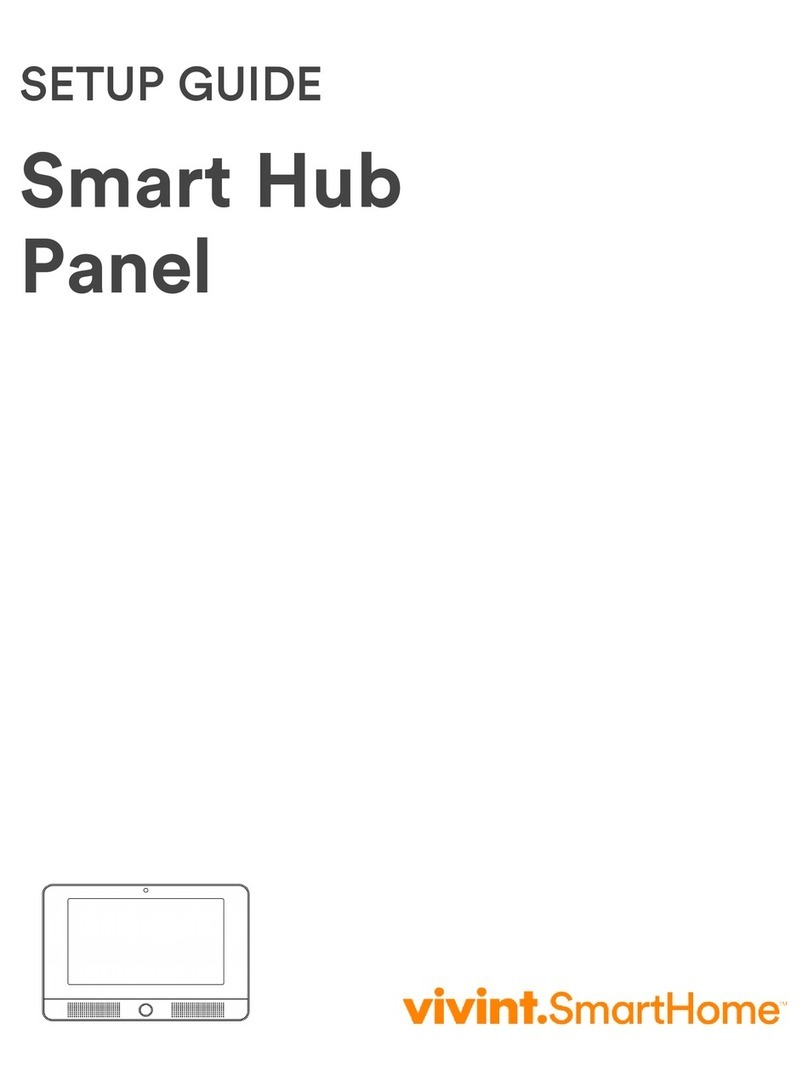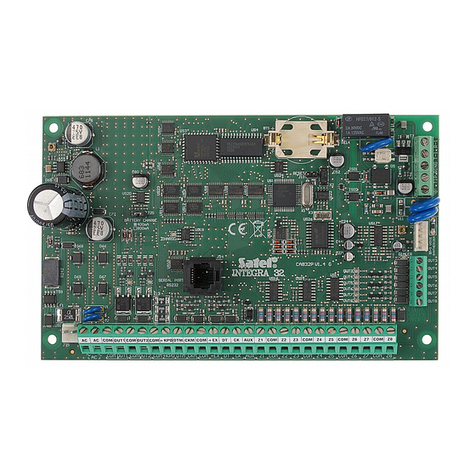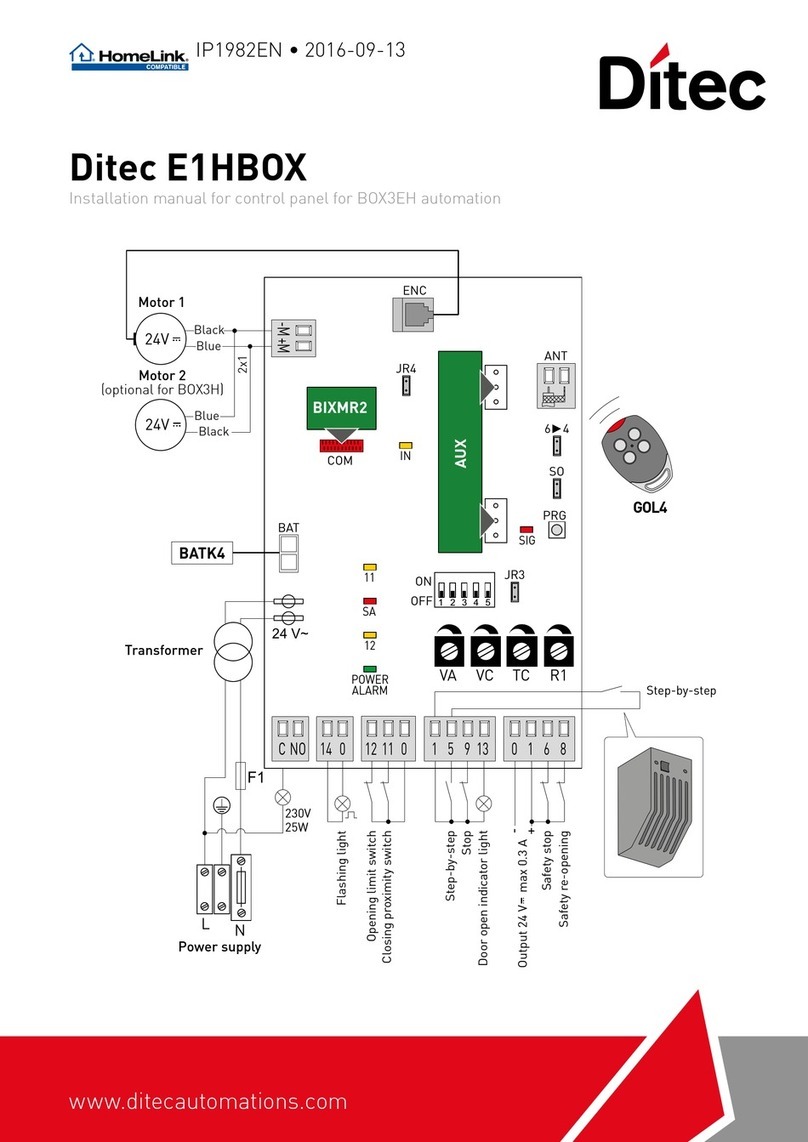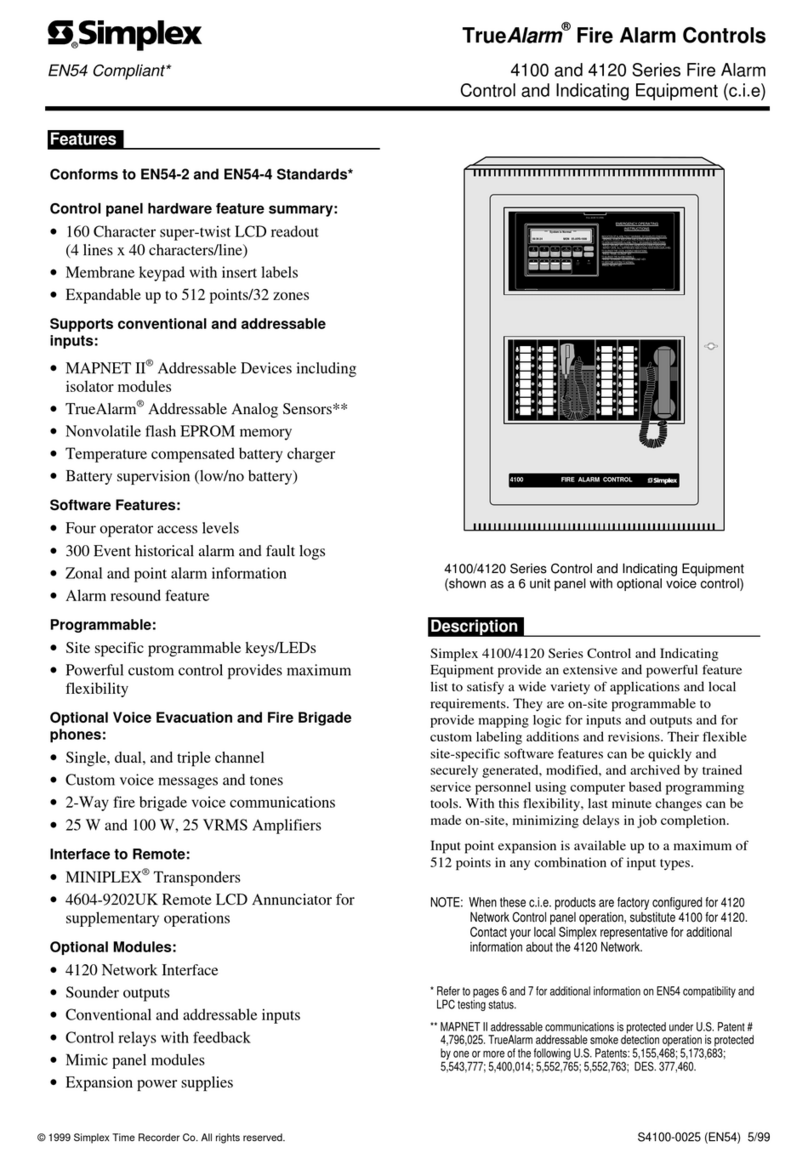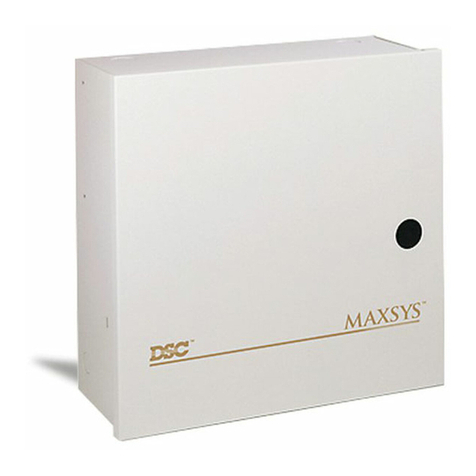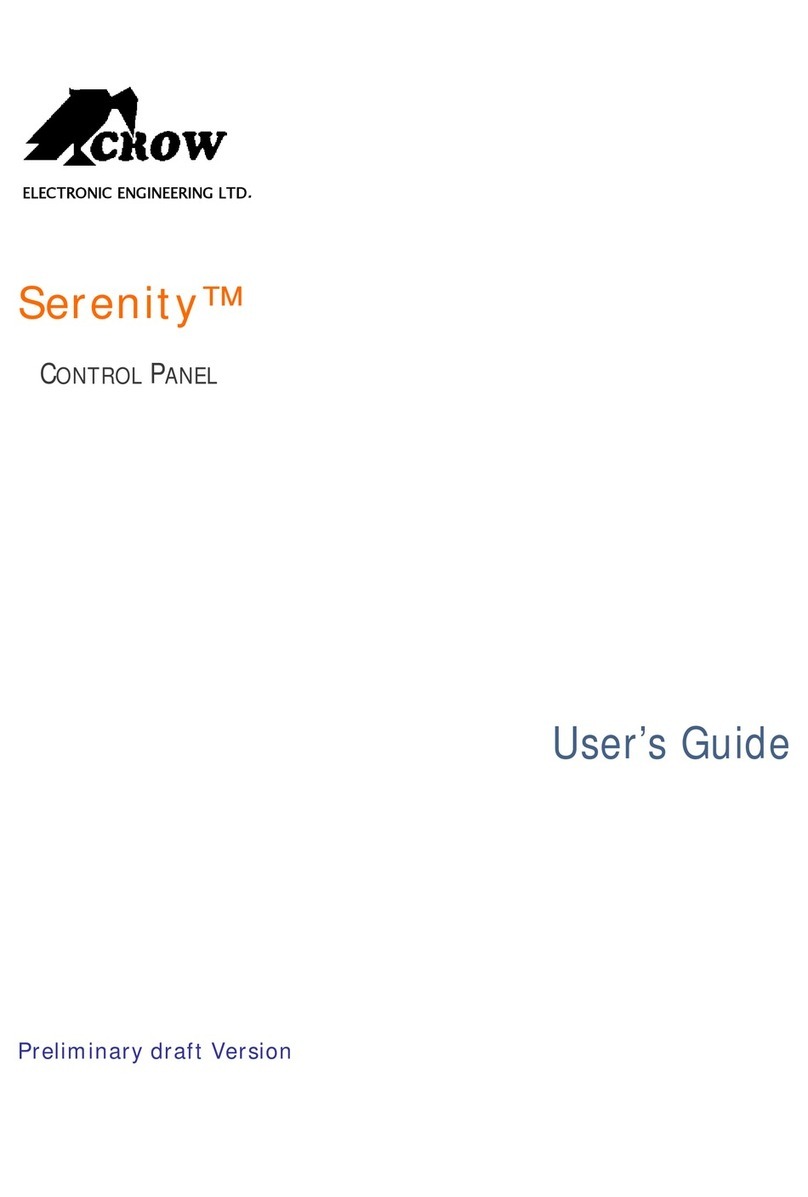DMP XF6 Installation guide

DIGITAL MONITORING PRODUCTS, INC.
INSTALLATION AND PROGRAMMING GUIDE
XF6 Series

B XF6 SERIES INSTALLATION AND PROGRAMMING GUIDE | DIGITAL MONITORING PRODUCTS
MODEL XF6 SERIES
Contains installation and programming Instructions for use with the
Model XF6 Series Fire Control Panels.
When using the XF6 Series panel for any listing organization’s approved methods, refer to the Compliance
Listing Guide (LT-2779). This document outlines the installation and programming requirements of all
applications for which XF6 Series control panels are approved.
© 2023 Digital Monitoring Products, Inc.
Information furnished by DMP is believed to be accurate and reliable.
This information is subject to change without notice.

XF6 INSTALLATION AND PROGRAMMING GUIDE | DIGITAL MONITORING PRODUCTS I
ABOUT THE PANEL................................1
Zone Expansion ...................................................................1
Output Expansion ...............................................................1
SPECIFICATIONS SUMMARY ................2
Power Supply........................................................................2
Communication....................................................................2
Panel Zones (24 VDC).......................................................2
NAC BUS (24 VDC) ............................................................2
Keypad Bus (12 VDC).........................................................2
LX-Bus (12 VDC) ..................................................................2
Outputs ...................................................................................2
SYSTEM COMPONENTS .........................3
Lightning Protection ..........................................................3
INSTALL THE PANEL..............................4
Mount the Enclosure ..........................................................4
Fire Command LCD Keypad............................................5
Mounting Additional Keypads, Zone Expanders,
and Modules ..........................................................................5
WIRE THE PANEL ...................................6
Wiring Specifications.........................................................6
Wire the Transformer.........................................................6
Wire the Batteries ...............................................................6
Power Requirements..........................................................7
LX-Bus Expansion ...............................................................10
Wireless Bus Expansion....................................................10
Ethernet Connection..........................................................10
RESET and TAMPER Headers.........................................10
AUX Output ...........................................................................11
Keypad Bus............................................................................11
Smoke Output ......................................................................11
NAC Circuits ..........................................................................11
Zones........................................................................................12
Dry Contact Relay Outputs .............................................13
Annunciator Outputs .........................................................13
ACCESSORY DEVICES ...........................14
Accessories............................................................................14
PROGRAMMING......................................17
XF6 Programming Information......................................17
Getting Started.....................................................................17
Accessing the user menu .................................................17
Reset Timeout.......................................................................17
Keypads...................................................................................18
Special Keys...........................................................................18
Entering Alpha Characters...............................................18
Keypad Displays Current Programming .....................18
INITIALIZATION......................................20
Initialization ...........................................................................20
Clear All Memory.................................................................20
Clear All Codes.....................................................................20
Clear Display Events Memory.........................................20
Clear Zone Information .....................................................20
Clear Output Information.................................................20
Clear Communication and Remote Options.............20
Set to Factory Defaults .....................................................20
COMMUNICATION...............................................................21
Communication....................................................................21
Account Number .................................................................21
Communication Path .........................................................21
Communication Type.........................................................21
Test Report.............................................................................21
Test Time.................................................................................21
Check In ..................................................................................21
Fail Time..................................................................................22
Receiver IP .............................................................................22
Receiver Port.........................................................................22
Fail Test Hours ......................................................................22
Protocol...................................................................................22
Retry Seconds ......................................................................22
Duplicate Alarms .................................................................22
Send Path Information ......................................................22

II XF6 SERIES INSTALLATION AND PROGRAMMING GUIDE | DIGITAL MONITORING PRODUCTS
NETWORK OPTIONS..............................23
DHCP........................................................................................23
Local IP Address .................................................................23
Gateway Address.................................................................23
Subnet Mask..........................................................................23
DNS Server.............................................................................23
DEVICE SETUP........................................24
Device Setup .........................................................................24
Device Number.....................................................................24
Device Name .........................................................................24
Device Type ...........................................................................24
REMOTE OPTIONS .................................25
Remote Options...................................................................25
Cell APN..................................................................................25
Entré Connection.................................................................25
Entré Incoming TCP Port..................................................25
Entré IP Address ..................................................................25
Entré Outbound TCP Port................................................25
Entré Backup Connection ................................................25
Entré Backup TCP Port .....................................................25
Entre Reports........................................................................25
User Command Reports ...................................................26
Supervisory Reports...........................................................26
Entré Passphrase .................................................................26
Integrator Connection .......................................................26
Integrator Incoming TCP Port ........................................26
Integrator IP Address.........................................................26
Integrator Outbound TCP Port.......................................26
Integrator Backup Connection.......................................26
Integrator Backup TCP Port ............................................26
Integrator Reports ..............................................................26
Zone Reports ........................................................................27
User Command Reports ...................................................27
Supervisory Reports...........................................................27
Integrator Passphrase........................................................27
App Key...................................................................................27
SYSTEM OPTIONS ..................................28
System Options....................................................................28
Cross Zone Time..................................................................28
Zone Retard Delay ..............................................................28
Power Fail Delay ..................................................................28
Swinger Bypass Trips.........................................................28
Time Changes .......................................................................28
Latch Supervisory Zones..................................................29
Programming Menu Language.......................................29
Detect Wireless Jamming ................................................29
Wireless Encryption ...........................................................30
Enter Passphrase .................................................................30
Trouble Audible Annunciation........................................30
Bell Options ...........................................................................31
Bell Options ...........................................................................31
Bell Cuto Time ...................................................................31
NAC 1 Sync Protocol...........................................................31
NAC 2 Sync Protocol..........................................................31
Selective Silence ..................................................................31
Bell Output.............................................................................31
Bell Action..............................................................................31
Fire Bell Action.....................................................................31
Supervisory Bell Action.....................................................31
Carbon Monoxide (CO) .....................................................31
OUTPUT OPTIONS..................................32
Output Options ....................................................................32
Cuto Output .......................................................................32
Output Cuto Time ............................................................32
Communication Trouble Output....................................32
Fire Alarm Output...............................................................32
Fire Trouble Output............................................................32
Device Fail Output ..............................................................32
Sensor Reset Output..........................................................33
Supervisory Alarm Output...............................................33
AC Fail Output......................................................................33
Carbon Monoxide Alarm Output...................................33

XF6 INSTALLATION AND PROGRAMMING GUIDE | DIGITAL MONITORING PRODUCTS III
Output Information.............................................................34
Output Number....................................................................34
Output Name ........................................................................34
Output Real-Time Status ..................................................34
Output Groups......................................................................35
Group Number......................................................................35
Group Name ..........................................................................35
Output Number....................................................................35
ZONE INFORMATION.............................36
Zone Information.................................................................36
Zone Number........................................................................36
Zone Name.............................................................................36
Fire Bell Output....................................................................37
Expander Serial Number ..................................................37
Next Zone...............................................................................37
Wireless...................................................................................37
Serial Number Entry...........................................................37
Contact....................................................................................38
Supervision Time .................................................................38
Alarm Action .........................................................................38
Output Number....................................................................38
Output Action.......................................................................38
Swinger Bypass....................................................................39
Zone Retard Delay ..............................................................39
Fast Response ......................................................................39
Fire Panel Slave Input ........................................................39
STOP .........................................................40
Stop ..........................................................................................40
SET LOCKOUT CODE .............................41
Set Lockout Code................................................................41
APPENDIX................................................42
Diagnostics Function .........................................................42
Using the Walk Test............................................................44
Walk Test.................................................................................44
Zone Types.............................................................................44
Trip Counter For Walk Test..............................................44
Trip Counter For DMP Wireless Check-in Test
(WLS).......................................................................................45
Test End Warning ................................................................45
Keypad Speaker Operation .............................................45
Wireless Check-in and Supervision Definitions .......46
Zone Type Descriptions ....................................................46
Common Keypad Messages ............................................47
FCC INFORMATION................................48
Part15 ......................................................................................48

XF6 Series Installation and Programming Guide Digital Monitoring Products
1
ABOUT THE PANEL
The DMP XF6 Series system consists of an alarm panel with a built-in communicator, an enclosure with built-in Graphic
Fire Command keypad, and a 28 VAC 130 VA transformer. A complete system can provide:
• 138 or 570 programmable inputs and outputs for commercial and industrial fire alarm service
• Six onboard 24 V class B grounded zones, 2 NAC circuits
The powered zones have a reset capability to provide for2-wire smoke detectors, relays, or other latching devices.
Addressable smoke detectors and input modules round out the XF6 Series Series panel to deliver a truly flexible and
expansive fire detection and notification system. The Fire Alarm Control Panel is shipped ready to mount in a red steel
enclosure. It is not necessary to remove the panel PCB when installing the enclosure.
ZONE EXPANSION
The keypad bus features up to 64 zones (16 addresses with 4 zones per address)
Six 24 V zones on the terminal strip
Up to500zones are available using the on board LX-Bus connections. All 500 zones can be wireless.
OUTPUT EXPANSION
In addition to the two SPDT relays and four programmable open collector outputs on the panel, you can also connect up
to25programmable Model716Output Expansion Modules to each LX-Bus. These modules can provide an additional 100
or 500 programmable SPDT relays.

SPECIFICATIONS SUMMARY
For a full list of compatible panel accessories, refer to "Accessory Devices".
POWER SUPPLY
Transformer— Input: 120V 60Hz, 1.3 Amp; Output: 28VAC 130VA
Standby Battery—24VDC (Two 12V batteries wired in series), 1.5Amps Max. charging current
Smoke and Auxiliary—24VDC output at 0.75Amp Max (not shared)
NAC Circuit 1 and NAC Circuit 2—24VDC at 2.5Amp Max
All combined circuits cannot exceed3.5Amps. All circuits are power limited except the red battery wire and AC terminal.
COMMUNICATION
• Built-in network communication to SCS-1R and SCS-VR Receivers
• Optional cellular communication to SCS-1R and SCS-VR Receivers
• Can operate as a local panel
PANEL ZONES (24 VDC)
Sixpowered zones (3.3k EOL).
NAC BUS (24 VDC)
The two onboard NAC circuits support the following protocols:
• DMP
• Gentex
• Wheelock
• System Sensor
KEYPAD BUS (12 VDC)
You can connect the following supervised keypads and expansion modules to the Keypad Bus:
• Alphanumeric keypads
• Sixteen, eight, four, and single-zone expansion modules
• Single zone detectors
LX-BUS (12 VDC)
You can connect the following devices to the LX-Bus connections provided on the panel. See Accessory Devices for
information about specific connections.
• Sixteen, eight, four, and single-zone expansion modules
• Relay output expansion modules
• 2W-BLX/2WT-BLX Addressable Smoke Detectors
OUTPUTS
The XF6 Series panel provides two Single Pole, Double Throw (SPDT) relay outputs which require the installation of two
Model305relays, each rated1Amp at30VDC resistive (power limited sources only). A Model431Output Harness is
required to use these outputs.
The panel also provides four open collector outputs rated for50mA each. The open collector outputs provide ground
connection for a positive voltage source. A Model300Output Harness is required to use these outputs.
Digital Monitoring Products XF6 Series Installation and Programming Guide
2

XF6 Series Installation and Programming Guide Digital Monitoring Products
3
XF6 Series Wiring Diagram
WARNING: Incorrect connections
may cause damage to the unit.
Listed Resistors
10k Ohm - DMP Model 308
3.3k Ohm - DMP Model 309
1k Ohm - DMP Model 310
1k Ohm - DMP Model 311
Use Listed Power Supervision Relay
rated at 24 VDC.
Smoke
Detector
Zone Expander
Model 715
7 mA @ 12 VDC
Models 715-8, 715-16
20 mA @ 12 VDC
1k Ohm
S
= Supervised Circuit
Zone
5
Zone
6
22 gauge minimum
22 gauge minimum
22 gauge minimum
22 gauge minimum
RED
YELLOW
GREEN
BLACK
Zone Expander
Model 714
7 mA @ 12 VDC
Models 714-8, 714-16
20 mA @ 12 VDC
RED
YELLOW
GREEN
BLACK
ss
s s s s
ss
S S S S S S S S
S S
S SS SS S
Zone
Expander
Model 711
or 711S
7mA @ 12
VDC
1k Ohm 1k Ohm 1k Ohm 1k Ohm
RED
BLACK
Zone
1
Zone
2
Zone
3
Zone
4
All zones use 3.3k Ohm Resistors
All zones use 3.3k Ohm Resistors
AC AC B+ B- AUX GND RED YEL GRN BLK SMK GND NAC1+ NAC1- NAC2+ NAC2- Z1+ Z1- Z2+ Z2- Z3+ Z3- Z4+ Z4- Z5+ Z5- Z6+ Z6-
Cell Module
Ethernet (Supervised)
RESET
LOAD
PROG LX600 LX700 LX800 LX900
LX500
BAT T STA RT
TAMPER
OUTPUT 1 OUTPUT 2
1100 WIRELESS XBUS
(Supervised)
EXP
XF6 Series Panel
To pre-installed 130 VA power
supply
Connect to 120V 60 Hz circuit
with 1.3 Amp not controlled
by switch
24 VDC Connections
12 VDC Connections (Supervised)
The XF6-100 only
contains one
LX-Bus connection
3.3k Ohm EOL
FOR FUTURE USE
12 VDC Connection
NAC
1
NAC
2
s
s
ssssssssssssss
ss
PWR
Maximum impedance is 100 Ohmns
LINK LED ACTIVITY LED
Use Model 305 Relay
for Outputs 1 and 2
CAUTION: DO NOT USE LOOPED WIRE UNDER
TERMINALS. BREAK WIRE RUN TO PROVIDE
SUPERVISION OF CONNECTIONS.
Using verification
delays is optional. Use
the delays marked on
the smoke detectors.
Wiring on terminals 7 through 16 must exit right and maintain 1/4"
separation from the Battery and Auxiliary wiring.
Intended Installation Environment - Indoor/Dry
All Circuits (Class B):
Impedance value for testing at
which open circuit faults, short
circuit faults, and ground faults
prevent normal operation.
Open - Infinite
Shorts - 0.1 Ohms
Ground - 0.1 Ohms
7830F Keypad
Outputs 3-6
To 24 VDC battery
LX and Keypad Bus:
Use one bus per notification
area (zone)
¼"
¼"
AC AC B+ B- AUX GND RED YEL
Nominal circuit voltage 24 VDC
Maximum short circuit current 62mA
SYSTEM COMPONENTS
The diagram below shows some of the accessory modules you can connect for use in various applications. A brief
description of each module follows in the Ordering Information section.
28 VAC 130 VA wire-in
transformer
Maximum 12/24VDC output
per circuit (Cannot exceed
3.5 amps combined output)
24 VDC Circuits:
• NAC 1 - 2.5 A
• NAC 2 - 2.5 A
• Battery Charging - 1.5 A
• SMK/AUX - .75 A
(Special Application)
12 VDC Circuits
• Keypad - 1 A
• LX-Bus - .70 A each
• X-Bus - .7 A each
NAC Circuit:
Supervised, Power Limited
Battery Backup
Regulated 0.25A
Special Application 2.5A
Maximum Line Loss 2V
Smoke/Auxiliary Power:
Supervised (Ground Only),
Power Limited
Battery Backup
24 VDC nominal rated
voltage
Form C Relays
Programmable
3.0 VDC, 1 A, 0.35 power
factor, Resistive, Power
Limited
All circuits are inherent
Power Limited except the
red battery wire and AC
terminal.
Open Collector Outputs 3-6,
Programmable
12V 30mA
The open collector output
must be connected to
devices located within the
same room as the panel.
LIGHTNING PROTECTION
Metal Oxide Varistors and Transient Voltage Suppressors help protect against voltage surges on panel input and output
circuits. Additional surge protection is available with Model370or370RJ Lightning Suppressors. For more information,
refer to the 370/370RJ Installation Sheet (LT-0181).

Digital Monitoring Products XF6 Series Installation and Programming Guide
4
INSTALL THE PANEL
MOUNT THE ENCLOSURE
The XF6 Series Series panel enclosure must be mounted using the four mounting holes shown in the image below.
Mount the enclosure in a secure, dry place to protect the panel from damage from tampering or the elements. It is not
necessary to remove the panel PCB when installing the enclosure.
The enclosure dimensions are13.44” H X17.1” W X4.8” D.
Note: For additional standby batteries, use the Model350, 349, or352S enclosures.
Battery shelf holds up to two batteries. Maintain
minimum spacing of 1/4” between the batteries
and any modules mounted in enclosure.
A
B
C
Panel
Transformer
Enclosure Mounting Holes
D
E
1-3/4” Knockouts
Module Mounting Holes
FBattery Shelf
E
E
E
DD
C C
C C
A
F
B
GGround
G

XF6 Series Installation and Programming Guide Digital Monitoring Products
5
FIRE COMMAND LCD KEYPAD
A 7830F Fire Command Keypad is factory installed on the panel enclosure door. The display and keyboard are factory
pre-wired to the PROG header. For standby battery calculations, the LCD display draws 140 mA of current in normal or
standby conditions, and 180 mA in the alarm condition. For more information, refer to "Power Requirements".
Additional 7830F keypads can be added as needed.
MOUNTING ADDITIONAL KEYPADS, ZONE EXPANDERS, AND MODULES
All DMP keypad housings are designed to install on any 4” square box, 3-gang switch box, compatible backboxes, or
directly on a flat surface.
The DMP711, 714, 715, and 716 modules are each contained in molded plastic housings with removable covers. The base
provides you with mounting holes for installing the unit to a wall, switch plate, or other surface.
Mount any additional modules in the panel enclosure using the standard 3-hole mounting pattern. Refer to the
appropriate product guides for installation instructions.
7830F Fire Command Keypad

Digital Monitoring Products XF6 Series Installation and Programming Guide
6
WIRE THE PANEL
WIRING SPECIFICATIONS
DMP recommends using 18 or 22 AWG for all LX-Bus, NAC, and Keypad Bus connections. The maximum wire distance
between any module and the DMP Keypad Bus or LX-Bus circuit is 1,000 feet. To increase the wiring distance, install an
auxiliary power supply, such as a DMP Model 505-12.
To maintain auxiliary power integrity when using 22-gauge wire on Keypad Bus circuits, do not exceed 500 feet. When
using 18-gauge wire, do not exceed 1,000 feet. Maximum distance for any bus circuit is 2,500 feet regardless of wire
gauge. Each 2,500 foot bus circuit supports a maximum of 40 LX-Bus devices. To increase the wire length or to add
devices, install an additional power supply that is listed for Fire Protective Signaling, power limited, and regulated
(24VDC nominal) with battery backup.
Maximum voltage drop between a panel or auxiliary power supply and any device is 2.0 VDC. If the voltage at any device
is less than the required level, add an auxiliary power supply at the end of the circuit.
For additional information refer to the LX-Bus/Keypad Bus Wiring Application Note (LT-2031) and the 710 Bus Splitter/
Repeater Module Installation Guide (LT-0310).
WIRE THE TRANSFORMER
The XF6 Series Series panel comes with a28 VAC 130VA transformer. Thetransformer must be wired to a dedicated,
unswitched120VAC60Hz circuit with at least 1.3Amps available.
Caution: Never share the Fire Alarm Control Panel circuit with any other equipment. Always ground the panel before
applying power to any devices and use 18 AWG or larger for all power connections.
WIRE THE BATTERIES
DMP recommends replacing batteries every3to5years under normal use. Connect the black battery lead to the
negative battery terminal. Connect the red battery lead to the battery positive terminal. The batteries will need to be
wired in series, meaning the black and red leads will be connected to dierent batteries with a jumper wire connecting
the two.
Caution: The XF6 Series panel requires two 12 VDC backup batteries wired in series. It cannot be powered by a
single 12 VDC backup battery.
For additional standby batteries, use a DMP Model349, 350or352S enclosure. All wiring shall run through conduit. The
enclosure shall be installed to the left of the panel enclosure to ensure Battery and AC wire separation.
Caution: Use sealed lead-acid batteries only. Batteries supplied by DMP have been tested to ensure proper charging
with DMP products. Do not use gel cell batteries.
Battery Only Restart
When powering up the XF6 Series Series panel without AC power, briefly short the battery start pads to pull in the
battery cuto relay. Once the relay has been pulled in, the battery voltage holds it in that condition.
If the panel is powered up with an AC transformer, the battery cuto relay is pulled in automatically.
Discharge/Recharge
The XF6 Series Series panel battery charging circuit float charges at27.6VDC at a maximum current of1.5Amps for a
maximum of 43 Ah. Battery voltage level conditions are determined by the following voltage ranges:
• Battery Trouble—Below23.4VDC
• Battery Cuto—Below20VDC
• Battery Restored—Above24.6VDC

XF6 Series Installation and Programming Guide Digital Monitoring Products
7
Battery Supervision
The panel tests the battery when AC power is present. The test is done every three minutes and lasts for five seconds.
During the test, the panel places a load on the battery. If the battery voltage falls below23.4VDC a low battery is
detected. If AC power is not present, a low battery is detected any time the battery voltage falls below23.4VDC. When
battery voltage drops below20VDC, the panel performs a battery cuto to prevent deep discharge damage.
If a low battery is detected with AC power present, the test repeats every two minutes until the battery charges
above24.6VDC. If a weak battery is replaced with a fully charged battery, the restored battery will not be detected until
the next test is completed.
POWER REQUIREMENTS
During AC power failure, the XF6 Series panel and all connected auxiliary devices draw their power from the battery. All
devices must be taken into consideration when calculating the battery standby capacity. The following table lists the
XF6 Series panel power requirements. You must add the additional current draw of keypads, zone expansion modules,
smoke detector output, and any other auxiliary devices used in the system for the total current required. The total is then
multiplied by the number of standby hours required to calculate the total ampere-hours required.
Standby Battery Power Calculations Standby Current Alarm Current
XF6 Series Fire Control Panel
7830F Fire Command Keypad
Relay Outputs (ON)
Switch Grounds (ON)
Active Zones
NAC Zones
2-Wire Smoke Detectors
Qty 1
Qty _______
Qty _______
Qty _______
Qty _______
Qty _______
Qty _______
x
x
x
x
x
x
x
90 mA
84 mA
3 mA
7 mA
7 mA
mA
mA
______mA
______
______
______
______
______
______
Qty 1
Qty _______
Qty _______
Qty _______
Qty _______
Qty _______
Qty _______
x
x
x
x
x
x
x
102 mA
108 mA
3 mA
61 mA
7 mA
mA
mA
______mA
______
______
______
______
______
______
263LTE Cellular Communicator
Qty _______ x 12 mA ______ Qty _______ x 12 mA ______
1100X Wireless Receiver Qty _______ x 15 mA ______ Qty _______ x 21 mA ______
1100XH Wireless High Power Receiver Qty _______ x 45 mA ______ Qty _______ x 61 mA ______
860 Relay Output Module (one relay active)
All four relays active
Qty _______ x 20 mA
83 mA
______
______
Qty _______ x 20 mA
83 mA
______
______
865 Class A or B Notification Module Qty _______ x 16 mA ______ Qty _______ x 51 mA ______
866 Class B Notification Module Qty _______ x 27 mA ______ Qty _______ x 46 mA ______
867 LX-Bus Class B Notification Module Qty _______ x 18 mA ______ Qty _______ x 52 mA ______
7830F Fire Command Keypad Qty _______ x 84 mA ______ Qty _______ x 108 mA ______
630F Remote Fire Command Center Qty _______ x 38 mA ______ Qty _______ x 55 mA ______
7070/7170 Thinline/7070A Aqualite Keypad
Active Zones (EOL Installed)
Qty _______ x 43 mA
1 mA
______
______
Qty _______
Qty _______
x
x
52 mA
1 mA*
______
______
7073/7173 Thinline/7073A Aqualite Keypad
Active Zones (EOL Installed)
Qty _______ x 51 mA
1 mA
______
______
Qty _______
Qty _______
x
x
60 mA
1 mA*
______
______
Copy Sub-Totals to next page Sub-Total Standby ______ mA Sub-Total Alarm
______ mA
*Based on 10% of active zones in alarm.

Digital Monitoring Products XF6 Series Installation and Programming Guide
8
Standby Battery Power Calculations Standby Current Alarm Current
710 Bus Splitter/Repeater Module Qty _______ x 19 mA ______ Qty _______ x 19 mA ______
711/711S Zone Expansion Module
Active Zone (EOL Installed)
Qty _______
Qty _______
x
x
7 mA
1 mA
______
______
Qty _______
Qty _______
x
x
7 mA
1 mA*
______
______
714 Zone Expansion Module
Active Zones (EOL Installed)
Qty _______
Qty _______
x
x
4 mA
1 mA
______
______
Qty _______
Qty _______
x
x
4 mA
2 mA*
______
______
714-8, 714-16 Zone Expansion Module
Active Zones (EOL Installed)
Qty _______
Qty _______
x
x
12 mA
1 mA
______
______
Qty _______
Qty _______
x
x
12 mA
1 mA*
______
______
715 Zone Expansion Module
Active Zones (EOL Installed)
2-Wire Smokes
Qty _______
Qty _______
Qty _______
x
x
x
4 mA
2 mA
.1 mA
______
______
______
Qty _______
Qty _______
Qty _______
x
x
x
4 mA
34 mA*
18 mA
______
______
______
715-8, 715-16 Zone Expansion Modules
Active Zones (EOL Installed)
2-Wire Smokes
Qty _______
Qty _______
Qty _______
x
x
x
12 mA
2 mA
.1 mA
______
______
______
Qty _______
Qty _______
Qty _______
x
x
x
12 mA
34 mA*
18 mA
______
______
______
716 Output Expansion Module
Active Form C Relays
Qty _______ x 4 mA ______ Qty _______
Qty _______
x
x
4 mA
17 mA
______
______
2W-BLX, 2WT-BLX Smoke Detectors Qty _______ x 9 mA ______ Qty _______ x 21 mA* ______
COSMOD2W Module Qty _______ x 27 mA ______ Qty _______ x 104 mA*# ______
COSMO-2W Smoke and CO Detectors Qty _______ x .6 mA ______ Qty _______ x 30 mA*# ______
572 Indicator LED Qty _______ x 12 mA ______ Qty _______ x 12 mA ______
Aux. Powered Devices on Terminals 7 and 11
Other than Keypads and LX-Bus Modules
______mA ______mA
Sub-Totals this page Sub-Total Standby ______ mA Sub-Total Alarm ______mA
Sub-Totals from previous page Sub-Total Standby ______ mA Sub-Total Alarm ______mA
*Based on 10% of active zones in alarm Total Standby ______ mA Total Alarm ______mA
# For systems that are not Central Station monitored, multiply alarm current by 12.
Total Standby ______ mA x number of Standby Hours needed _____= _____ mA-hours
Total Alarm ______ mA x number of Alarm Hours needed _____ = _____ mA-hours
UL 864 requires 5 minutes (.0833 hours) in Alarm Total _____ mA-hours
Add 10% for battery derating = _____ Amp-hrs Required
1Based on10% of active zones in alarm.
2For systems that are not central station monitored, multiply alarm current by12.
* Where h = hours of alarm. For example, a 15 minute alarm = 0.25 h.

XF6 Series Installation and Programming Guide Digital Monitoring Products
9
Standby Battery Selection
To choose the type and number of batteries needed for 24 hours of standby power based on the Amp Hours Required
calculation, perform the following:
• 1. Select the desired standby hours required from the table below: 24 hours.
• 2. Select the desired battery size: Model 368 (12 VDC 5.0 Ah), Model 369 (12 VDC 7 Ah), Model 365 (12 VDC 9 Ah),
Model 366 (12 VDC 18 Ah).
• 3. Select a Max. Ah Available number that is just greater than the number calculated in Amp Hours Required.
• 4. Install the number of batteries shown in the corresponding No. of Batteries required column.
For listed installations, batteries can be installed in a DMP Model 349, 350 or 352S enclosure and all wiring shall run
through conduit. The enclosure shall be installed to the left of the XF6 Series enclosure to ensure Battery and Auxiliary
wire separation.
24 HOURS OF STANDBY POWER
5.0 Ah Batteries 7 Ah Batteries 7.7 Ah Batteries 9 Ah Batteries 18 Ah Batteries
Max. Ah
Available
No. of
Battery
Pairs
Max. Ah
Available
No. of
Battery
Pairs
Max. Ah
Available
No. of
Battery
Pairs
Max. Ah
Available
No. of
Battery
Pairs
Max. Ah
Available
No. of
Battery
Pairs
8 2 5 1 6 1 7 1 14 1
12 3 11 2 12 2 14 2 28 2
16 4 16 3 18 3 21 3 43 3
20 5 22 4 24 4 28 4
24 6 28 5 30 5 36 5
28 7 33 6 36 6
32 8 39 7
36 9 48 hours is the typical battery recharge time for any of the Number of Batteries shown in this section.
40 10
If the Amp Hours Required calculation is greater than any Max. Ah Available number shown on a table, then add power
supply(s) to power some system devices allowing the Amp Hours Required calculation to be reduced. See the 710 Bus
Splitter/Repeater Installation Guide (LT-0310).

Digital Monitoring Products XF6 Series Installation and Programming Guide
10
LX-BUS EXPANSION
There are five 12 VDC LX-Bus headers near the bottom of the panel:
• LX500 provides zones500-599 (XF6 Series)
• LX600 provides zones600-699 (XF6-500 Series only)
• LX700 provides zones700-799 (XF6-500 Series only)
• LX800 provides zones800-899 (XF6-500 Series only)
• LX900 provides zones900-999 (XF6-500 Series only)
Note: The XF6 does drops power to the LX-Bus during a sensor reset.
WIRELESS BUS EXPANSION
The Wireless Bus (XBUS) header provides connection for the1100X or1100XH Wireless Receiver. The XBUS provides up
to500wireless zones numbered500-999. Refer to the1100X Wireless Receiver Install Guide (LT-1822) or the1100XH
Wireless Receiver Install Guide (LT-1823) for complete information.
• XF6-100provides up to100zones
• XF6-500provides up to500zones
Wireless Bus LEDs
The two LEDs, located above the XBUS header, indicate data transmission and receipt. The left LED flashes green to
indicate the panel is transmitting data. The right LED flashes yellow to indicate the panel is receiving data.
ETHERNET CONNECTION
Description
The ETHERNET connector on the
XF6 Series Series panel allows you to connect
directly to an Ethernet network using a
standard Cat 5 cable. The ETHERNET connector
supports100Mbps full duplex operation and the
maximum impedance is100Ohms.
Ethernet LEDs
The two LEDs located on the top edge of the
connector indicate network connection. The right
Link LED (green) lights to indicate a valid receive
connection from the host network. The Activity
LED (yellow) lights when connected to a 100 Mbps
network and is o when connected to a 10 Mbps
network connection.
RESET AND TAMPER HEADERS
RESET Header
The RESET header is used to reset the panel. To reset the panel when installing the system, place the jumper across both
RESET pins before applying power to the panel. After connecting the AC and battery, remove the reset jumper.
To reset the panel while the system is operational, install the reset jumper without powering down the system. Remove
the reset jumper after one or two seconds.
After resetting the panel, begin programming within30minutes. Otherwise, you must reset the panel again to enter the
PROG menu.
TAMPER Header
The TAMPER header is designed to connect to a tamper switch with a tamper harness. One or more tamper switches can
be mounted inside the panel enclosure to supervise unauthorized removal or opening of an enclosure.
XF6 Series Panel Showing the RESET Jumper and Tamper
RESET
LOAD
PROG LX600 LX700 LX800 LX900
LX500
TAMPER
OUTPUT 1 OUTPUT 2
EXP
XF6 Series Panel
OUTPUTS 3-6

XF6 Series Installation and Programming Guide Digital Monitoring Products
11
AUX OUTPUT
Terminals5and6
Supplies positive24VDC to power alarm bells or horns. This output can be steady, pulsed, or temporal. Terminal6is
the ground reference for the aux circuit. This supervised output reads resistance of3.3kOhms or less as normal. The
indicating appliance can supply this resistance. If using a horn or siren, install the included3.3kOhm0.5W resistor
across the bell circuit to provide supervision. See the Notification Appliance section in the Compliance Listing Guide
(LT-2779) for wiring diagrams and a list of approved notification appliances.
KEYPAD BUS
Description
The panel 12 VDC Keypad Bus includes Terminals7, 8, 9, and10. You can connect up to fifteen supervised keypads and
multiple unsupervised keypads to the panel. In addition to DMP keypads, you can also connect any combination of zone
expansion modules. Refer to the specific device installation sheet for the maximum number of Keypad Bus devices. Refer
to the LX-Bus section for more information about LX-Bus expansion.
Terminal7 - RED
Supplies positive and regulated12VDC to power DMP LCD keypads and zone expansion modules. Terminal7also
supplies power for any auxiliary device. The ground reference for Terminal7is Terminal10.
The output current is shared with the smoke power output on Terminal11and zones9and10. Current draw for all
connected devices must not exceed the panel maximum current rating. See Power Supply in the Compliance Listing
Guide (LT-2779) for maximum current in a fire listed application.
Terminal8 - YELLOW
Receives data from keypads and zone expansion modules. It cannot be used for any other purpose.
Terminal9 - GREEN
Transmits data to keypads and zone expansion modules. It cannot be used for any other purpose.
Terminal10 - BLACK
The ground reference for DMP keypads, zone expansion modules, and all auxiliary devices being powered by Terminal7.
Programming (PROG) Connection
A 7830F Fire Command Keypad comes pre-installed and is connected to the programming header of the XF6 Series
panel.
OVC LEDs
The Overcurrent LED (OVC) lights red when the devices connected to the Keypad Bus and LX-Bus draw current that
exceeds the panel rating.
The LEDs turn a steady red when lit. When the OVC LEDs light red, the LX-Buses and Keypad Bus are shut down.
SMOKE OUTPUT
Terminals11and12
Supplies positive and regulated24VDC to power4-wire smoke detectors and other powered devices. This output can
be turned o by the user for5seconds using the Sensor Reset User Menu option to allow latched devices to reset.
Terminal12is the ground reference for Terminal11.
Current Rating
The Output current from Terminal11is shared with Terminals7, 25, and27.
The total current draw of all devices powered from the panel must be included with Terminal11calculations and must not
exceed the maximum output rating.
NAC CIRCUITS
Terminals13-16
Supplies two 24 VDC 2.5 Amp Class B NAC circuits. Requires 3.3k Ohm EOL resistor.

ZONES
Terminals17-28
Zones1to6 (Terminals17to28) on the panel are 24 VDC powered zones. For programming purposes, the zone numbers
are1through6. See the Compliance Listing Guide (LT-2779)for a list of the compatible2-wire smoke detectors. Do not
mix detectors from dierent manufacturers on the same zone.
Caution: Performing a Sensor Reset momentarily drops power to the devices on zones 1-6. The panel views these
zones as Open while power is absent.
When wiring powered zones for 2-wire smoke detectors, refer to the following specifications:
• Maximum wire length—3000feet (18AWG) or1000feet (22AWG)
• Maximum voltage—28VDC
• Maximum normal standby current—7.5mA DC
• Maximum line impedance—100Ohms
• Maximum short circuit current—63mA
The voltage sensing Terminal measures the voltage across a3.3k Ohm EOL resistor to ground. Use Model309 3.3k Ohm
resistors. Dry contact sensing devices can be used in series (normally-closed) or in parallel (normally-open).
Operational Parameters
Each protection zone detects three conditions: Open, Normal, and Short.
Zone Response Time
A condition must be present on a zone for500milliseconds before it is detected by the panel. Ensure detection devices
used on the protection zones are rated for use with this delay. Zones1-6can also be programmed for a fast response
delay of160milliseconds.
Terminal 13-24 Specifications
Terminal Function Terminal Function
17 Zone1positive 23 Zone4 positive
18 Zone 1 negative 24 Zone 4 negative
19 Zone2positive 25 Zone5 positive
20 Zone2 negative 26 Zone5 negative
21 Zone 3 positive 27 Zone 6 positive
22 Zone3 negative 28 Zone6 negative
Protection Zone Parameters
Condition Resistance on zone Voltage on positive terminal
Open Over6600ohms Over25.3VDC
Normal 1650to6600ohms 21.2to25.3VDC
Short Under1650ohms Under21.2VDC
Model 431 Output Wiring
Output 1 Output 2
Contact Color Contact Color
Normally Closed Violet Normally Closed Violet with white stripe
Common Gray Common White with gray stripe
Normally Open Orange Normally Open Orange with white stripe
Digital Monitoring Products XF6 Series Installation and Programming Guide
12

XF6 Series Installation and Programming Guide Digital Monitoring Products
13
DRY CONTACT RELAY OUTPUTS
The panel provides two programmable auxiliary SPDT relays when equipped with two DMP Model305relays in sockets
OUTPUT1and OUTPUT2and a Model431Output Harness on the OUT1-OUT2 6-pin header. Each relay provides one
SPDT set of contacts that can be operated by any of the functions listed below:
• Activation by zone condition—Steady, Pulsing, Momentary, and Follow
• Manual activation from the DMP LCD keypad menu
• Communication failure
• Fire Alarm, Fire Trouble, or Supervisory
Contact Rating
The Model305relay contacts are rated for1Amp at30VDC (allows 0.35power factor). You can connect auxiliary power
to the Relay Output1common terminal by installing the gray harness wire to Terminal7. Current draw for all connected
devices must not exceed the panel maximum current rating.
Model431Output Harness Wiring
The relay contacts are accessible by installing the DMP431Output Harness on the6-pin OUT1 OUT2header.
OUTPUT2uses the top three prongs, and OUTPUT1uses the bottom three prongs. The relay contacts must be
connected to devices located within the same room as the panel. The wire harness colors and contact locations are
shown below:
ANNUNCIATOR OUTPUTS
The four programmable annunciator outputs can be programmed to indicate the activity of the panel zones or
conditions occurring on the system. Annunciator outputs do not provide voltage. Instead, they switch voltage from
another source to ground. The outputs can respond to any of the conditions listed in Dry Contact Relays. Maximum
voltage is30VDC at50mA.
Model300Harness Wiring
Access the open collector outputs by installing DMP300Harness on the4-pin OUTPUTS header. The output locations
are shown below. For listed applications, devices connected to the outputs must be located within the same room as the
panel.
Model860Relay Module
Connect a Model860Relay Module to the OUTPUTS header on the panel to provide relays for outputs3-6. Use these
relays for electrical isolation between the alarm panel and other systems or for switching voltage to control various
functions. Power is supplied to the relay coils from a single wire connected to the panel auxiliary power Terminal7.
The module includes one relay and provides three additional sockets for expansion of up to four relays. Mount
the860inside the panel enclosure using the3-hole pattern and plastic standos. Refer to the860Module Install Sheet
(LT-0484) as needed. Relay Contact Rating is 1Amp at30VDC (allows 0.35power factor).

Digital Monitoring Products XF6 Series Installation and Programming Guide
14
ACCESSORY DEVICES
Panels
XF6-100 XF6-100Fire Control Panel with Network and Cell
XF6-500 XF6-500Fire Control Panel with Network and Cell
ACCESSORIES
Keypads
7830F-R Fire Command Keypad 32-character touchscreen Fire Command keypad.
630F LCD Remote Fire Command 32-character LCD Fire keypad with keyswitch.
Power Supplies
505-12 Power Supply A power-limited, switching power supply that meets UL, CSFM, NFPA and FCC
compliance standards. The 505-12is rated for 12VDC at 5amps maximum.
505-12LX Power Supply A power-limited, switching power supply that meets UL, CSFM, NFPA and FCC
compliance standards. 505-12LX is rated for 12VDC at 5amps maximum. Provides
two independent Class B NAC outputs. Each power supply includes a transformer,
battery leads and a metal enclosure.
Batteries and Battery Accessories
Batteries 365 9.0 Ah 12 VDC
366 18.0 Ah 12 VDC
368 5.0 Ah 12 VDC
369 7.0 Ah 12 VDC
349 Medium Enclosure Medium panel enclosure with dual-size knockouts, lock and key, and module
mounting holes. Dimensions: 13.5" W × 11.66" H × 3.55" D
350 Large Enclosure Holds three 7.7 Ah batteries or two 18.0 Ah batteries and module mounting holes.
Dimensions: 17.5" W × 13.5" H × 3.5" D
352S Extra Large Battery
Enclosure
Features five adjustable shelves to hold batteries for standby power.
Dimensions: 14.5" x 32" x 4" (lid adds 0.5" on each side)
Battery Harnesses 318 Standard battery leads
318R Ring-style battery leads
318T Terminal-style battery leads
318EXT 48" Battery lead extension
Cellular Communicators
263LTE-V/381-2 LTE Verizon
Cellular Communicator
Provides cellular communication for XF6 Series panels.
263LTE-A/381-2 LTE AT&T
Cellular Communicator
Provides cellular communication for XF6 Series Panels.
263LTE-FN/381-2 FirstNet
Cellular Communicator
Provides cellular communication for XF6 Series Panels over the FirstNet network.
Expansion Modules
710Bus Splitter/Repeater Expands the number of devices and length of wire on the LX-Bus or keypad bus.
Also provides wire connections for up to three additional LX-Bus circuits.
711Single Zone Expander Single-zone expander with screw terminal connections. Includes EOL resistors.
711S Single Zone Expander Single-zone expander with flying lead connections. Includes EOL resistor.
714 Zone Expansion Module Expander with four 5VDC Class B zones and rotary-switch addressing. Includes
EOL resistors and 12-wire harness.
714-8 Zone Expander Terminal block installation for eight Class B non-powered fire devices. Includes
enclosure with lock and key plus 1k EOL resistors.
714-16 Zone Expander Terminal block installation for 16Class B non-powered fire devices. Includes
enclosure with lock and key plus 1k EOL resistors.
715 Zone Expansion Module Provides 4 Class B zones (12VDC) for two-wire smoke detectors and other
powered or non-powered devices. Includes 3.3k EOL resistors and 12-wire harness.
715-8 Zone Expander Provides eight powered zones (12VDC) supporting two-wire smoke detectors or
other fire alarm initiating devices. Includes red 340 enclosure and EOL resistors.

XF6 Series Installation and Programming Guide Digital Monitoring Products
15
715-16 Zone Expander Provides 16 powered zones (12VDC) supporting two-wire smoke detectors or
other fire alarm initiating devices. Includes red 340 enclosure and EOL resistors.
716Output Expander Provides 4 programmable Form C (SPDT) relays and four open collector
annunciator outputs. Use the outputs for remote zone and system annunciation or
environmental control applications. Harness included.
Auxiliary Modules
860Relay Output Module Provides electrical isolation between the alarm panel and other systems or for
switching voltage to control various functions.
865 Class A/B Notification
Module
Provides Class A or B supervision for ground faults, opens, and shorts on
notification appliance circuits.
866 Class B Notification Module Provides one 5 Amp Class B notification circuit for supervising listed, polarized
notification devices such as bells, strobes, and horns.
867 Class B LX-Bus Notification
Circuit Module
Provides one supervised Class B circuit for 12 VDCor 28VDC notification devices.
The 867connects to the LX-Bus and supervises Ground Fault, Open and Short
conditions on the notification circuit.
Pull Stations
850Series Pull Stations Single or dual action pull stations with gold-plated SPST contacts and terminal
strip connections.
Smoke/Heat Detectors
2W-BLX Conventional Smoke
Detector
A photoelectric detector that includes an addressable single point module for
connection to the LX-Bus of the XF6 Series panels.
2WT-BLX Conventional Smoke/
Heat Detector
A photoelectric detector that includes an addressable single point module with a
restorable, built-in fixed temperature thermal detector and is capable of sensing a
temperature higher than 135 °F.
Miscellaneous Accessories
335Intrusion Siren Oers dual tones, steady and warble, is load-tested to four hours, is indoor surface-
mounted and is made out of UV-resistant, high-impact ABS plastic. 105dB.
370Lightning Suppressor Provides lightning supression for any DMP or other manufacturer’s panel.
861Power Distribution Module Provides multiple auxiliary power terminals and additional keypad and/or LX-Bus
connectors for a clean installation. Maximum current handling capacity of 8amps
on power and ground in terminals.
Wiring harnesses, cables, and
tampers
300Four-wire Harness
303Silence/Reset Push Button
305Plug-in Output Relay
306Tamper Harness
307-S Screw-On Tamper Switch
374Surge Voltage Suppressor
3012Clip-On Tamper Switch
381Coax Extension Cable
431Output Harness
Monitoring Center Receivers
SCS-1R Network Enabled
Receiver
Network Enabled Receiver compatible with central station receivers that accept
Standard CID, DD or DMP Serial 3messaging.
SCS-VR Virtual Receiver Software-only solution that runs on a server for network IP and cellular
communications.
DMP Wireless
1100X Receiver Provides Two-Way, supervised communication using 900MHz frequency hopping-
spread spectrum technology. 1100XE-W features 128-bit AES encryption.
1100XH High-Power Receiver Provides additional transmit and receive amplification for improved performance at
greater distance or harsh building environments. 1100XHE-W features 128-bit AES
encryption.
1100R Repeater Provides increased communication range. Up to eight repeaters can be installed on
a wireless system. This model includes the 376L power supply. 1100RE-W features
128-bit AES encryption.
1103Universal Transmitter,
External Contact
Includes an internal magnetic reed switch, an on board terminal block for external
contact wiring, and an end-of-line resistor. Features 128-bit AES encryption.
This manual suits for next models
2
Table of contents
Popular Control Panel manuals by other brands

AUTOTERM
AUTOTERM PU-5 operating manual
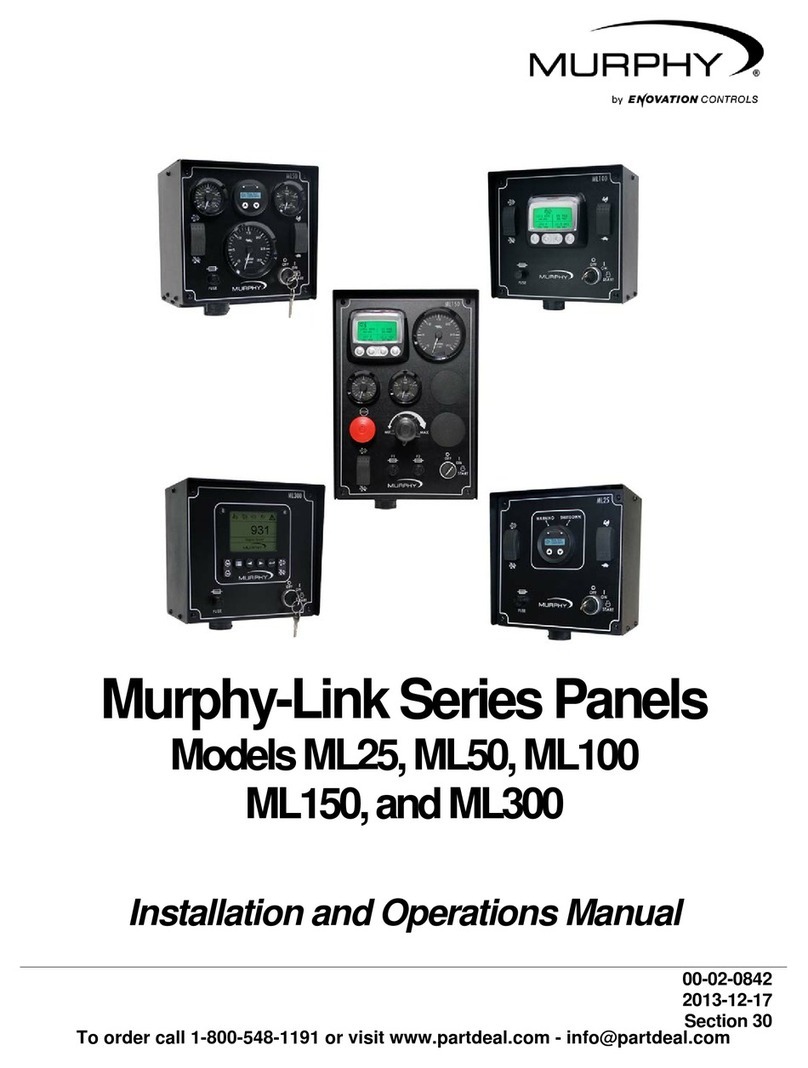
Enovation Controls
Enovation Controls Murphy-Link Series Installation and operation manual
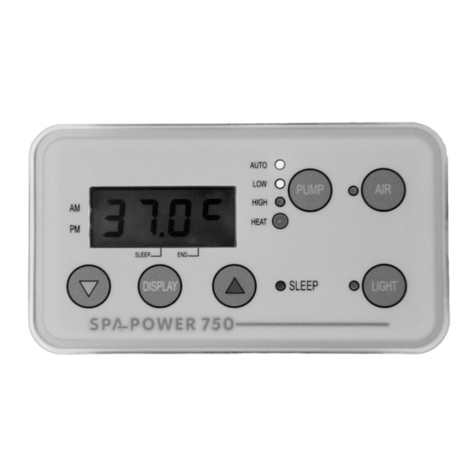
Spa-Quip
Spa-Quip Spa Power 750 Quick Card User Guide

Eaton
Eaton Greengate ControlKeeper CK4A-SSRC installation instructions
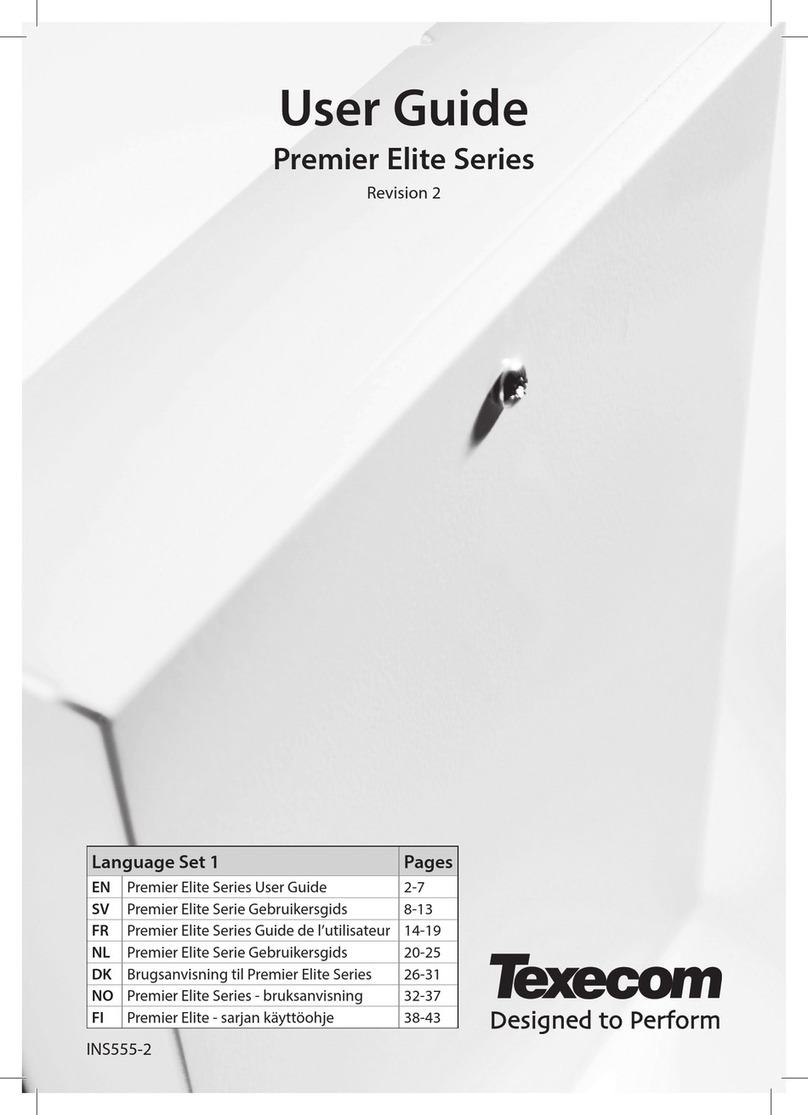
Texecom
Texecom Premier Elite Series user guide
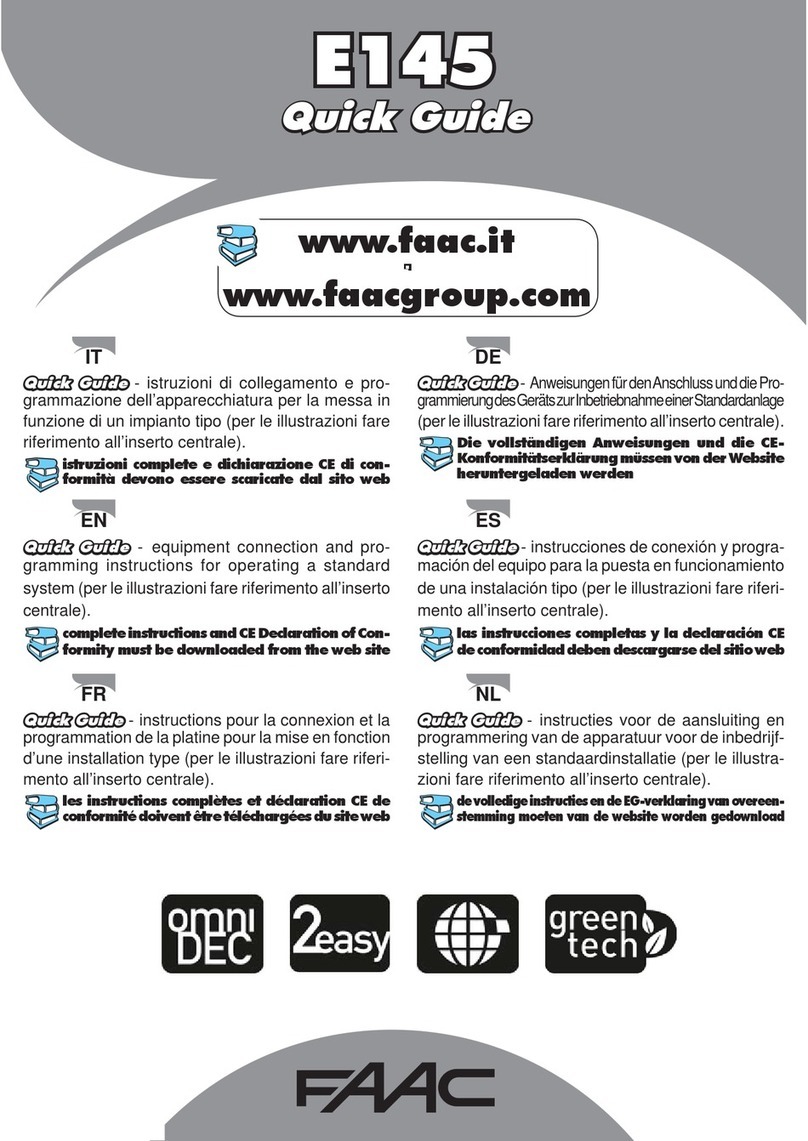
FAAC
FAAC E145 quick guide
